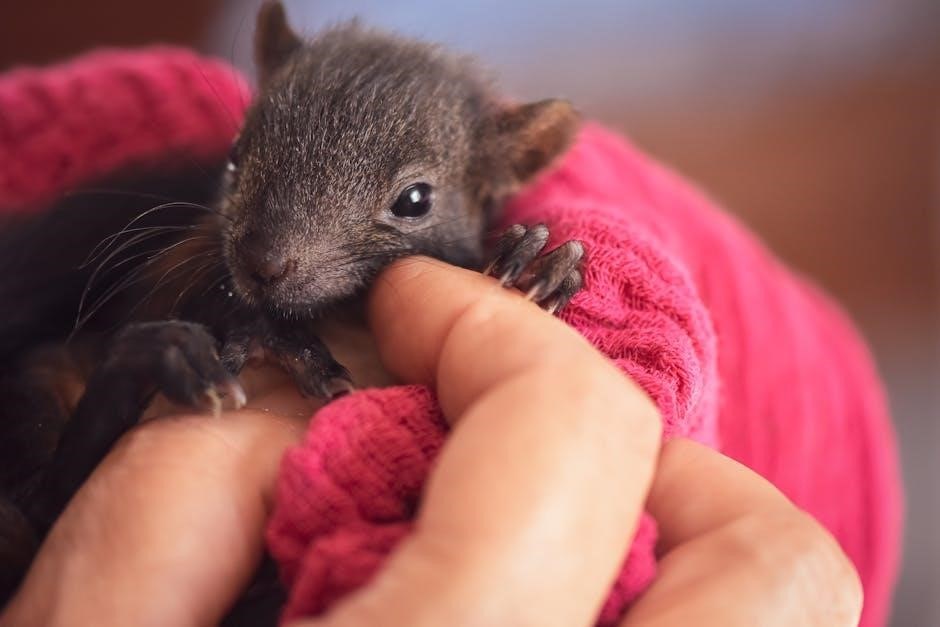baby squirrel care guide

Provide Warmth
Providing warmth is crucial for baby squirrels, as they rely on external heat sources. Use a supplemental heat source like a warm water bottle wrapped in cloth, placing it in a secure, enclosed container with the squirrel. Ensure the baby feels warmer than your skin; hypothermia can be fatal. Keep the environment dark and quiet to reduce stress. A warm, safe space helps the baby thrive and prepares it for further care.
Rehydration
Rehydration is the first critical step in caring for a baby squirrel, especially if it has been orphaned, injured, or exposed to the elements. Dehydration can quickly lead to serious health issues, so it’s essential to act promptly. Signs of dehydration include dry mouth, sunken eyes, and lethargy. If the squirrel feels cool to the touch or is unresponsive, rehydration is urgent.
The best way to rehydrate a baby squirrel is by using an unflavored Pedialyte solution or a homemade mixture of 1 teaspoon of sugar and 1 teaspoon of salt dissolved in 1 cup of warm water. Gently administer the solution using a small syringe or an eye dropper, placing a few drops directly into the squirrel’s mouth. Start with small amounts to avoid overwhelming the baby, offering 0.5-1 mL every 30 minutes to an hour until signs of dehydration improve.
Never feed a cold or dehydrated squirrel, as this can lead to further complications. Ensure the baby is warm to the touch before rehydration, as hypothermia will hinder its ability to absorb fluids. If the squirrel is extremely dehydrated, it may require more frequent administration of the solution. However, be cautious not to over-hydrate, as this can also be harmful.
Once the squirrel is rehydrated and warmed, you can gradually introduce a milk replacer specifically formulated for squirrels, such as Fox Valley 20/50 Formula or Wombaroo Squirrel Milk Replacer. Homemade goat milk formulas can be used temporarily but should not replace proper squirrel-specific nutrition.
Rehydration is a delicate process that requires patience and careful observation. Monitor the squirrel’s response closely, watching for improved alertness, moist eyes, and increased activity. If the baby squirrel does not improve or shows signs of distress, seek immediate assistance from a licensed wildlife rehabilitator or veterinarian.

Feeding Schedule
A proper feeding schedule is vital for the healthy development of a baby squirrel. The frequency and type of feedings depend on the squirrel’s age and developmental stage. For the first two weeks of life, baby squirrels require feeding every two hours around the clock. This means feeding them 8-10 times daily, including overnight. After the first two weeks, the frequency can be reduced to every three hours until their eyes open.
Once the baby squirrel’s eyes open, typically around 3-4 weeks of age, the feeding schedule can be adjusted to every 4 hours, totaling about 5 feedings per day. At 5 weeks old, the squirrel can be fed every 4-5 hours, reducing the number of feedings to 4-5 times daily. It’s important to stick to this schedule to ensure the squirrel receives adequate nutrition for growth and energy.
At approximately 6-8 weeks of age, the squirrel will begin transitioning to solid foods. Start by offering a high-quality squirrel-specific formula, such as Fox Valley 20/50 or Wombaroo Squirrel Milk Replacer, mixed to a thicker consistency. Gradually introduce small amounts of soft fruits, vegetables, and nuts appropriate for squirrels, like apples, berries, and hazelnuts. Avoid giving nuts and seeds exclusively, as they can lead to metabolic issues.
During the weaning phase (8-12 weeks), the squirrel will rely less on milk and more on solid foods. Offer the formula 2-3 times daily, supplementing with fresh fruits and vegetables. By 12 weeks of age, the squirrel should be fully weaned and eating independently, but it may still benefit from occasional formula feedings until release.
Always use a syringe or small bottle to feed the squirrel, ensuring it swallows correctly and doesn’t aspirate. If the baby squirrel is lethargic, cold, or dehydrated, delay feeding until it is warm and hydrated. Overfeeding can be harmful, so monitor the squirrel’s weight and overall health to avoid complications.
Stick to the feeding schedule diligently, as inconsistent feeding can lead to malnutrition and health problems. If unsure about the squirrel’s age or feeding needs, consult a wildlife rehabilitator for guidance.
Nutrition
Nutrition is a cornerstone of baby squirrel care, ensuring proper growth and development. The dietary needs of a baby squirrel vary by age and developmental stage, requiring careful attention to provide the right balance of nutrients. For the first few weeks of life, baby squirrels rely on milk replacers specifically formulated for squirrels, such as Fox Valley 20/50 Formula or Wombaroo Squirrel Milk Replacer. These formulas mimic the nutritional profile of a mother squirrel’s milk and are essential for healthy development.
As the squirrel grows, it’s important to gradually introduce solid foods. At around 5-6 weeks of age, start offering small amounts of soft, easy-to-digest foods like mashed apples, bananas, or berries. Avoid giving citrus fruits, as they can cause digestive issues. Introduce leafy greens like kale or spinach sparingly, as they can be too rich for young squirrels. Nuts and seeds should be offered in moderation, as they are high in fat and calories, which can lead to obesity and metabolic problems if overfed.
By 8-10 weeks of age, the squirrel’s diet should consist of a mix of high-quality commercial squirrel food, fresh fruits, vegetables, and limited nuts. Avoid offering human foods like dairy products, bread, or processed snacks, as these can be harmful. Always provide fresh water daily to ensure proper hydration, and consider offering an electrolyte-rich solution like Pedialyte occasionally to prevent dehydration.
Avoid homemade formulas or substitutions, as they often lack the necessary nutrients or can cause digestive issues. Stick to reputable, commercially available squirrel formulas and foods to ensure the baby squirrel receives a balanced diet. If unsure about specific nutritional needs, consult a wildlife rehabilitator or veterinarian for guidance.
Nutritional balance is critical to prevent health problems and ensure the squirrel thrives. A well-fed baby squirrel will have bright eyes, a bushy tail, and steady weight gain. Proper nutrition sets the foundation for a healthy, active life, whether the squirrel is being raised for release or as a pet.

Stimulation for Elimination
Stimulating elimination is a critical step in caring for baby squirrels, especially during the first few weeks of life. Mother squirrels naturally lick their babies to encourage urination and defecation, and this process must be replicated when raising an orphaned squirrel. Without proper stimulation, the baby squirrel may experience urinary retention or constipation, which can lead to serious health issues.
To stimulate elimination, gently use a warm, wet cotton ball, soft cloth, or the tip of your finger to lightly rub the genital area. This mimics the mother’s natural licking and helps the baby relax and release. Perform this stimulation immediately after feeding to ensure the squirrel eliminates properly. Be careful not to press too hard, as this could cause discomfort or injury.
Signs that the stimulation is working include the release of urine (which may appear as a small droplet or stream) or the passing of stool (which is typically small and dark in color). If the baby squirrel does not respond to stimulation, it may indicate a deeper issue, such as dehydration or illness, and you should seek advice from a wildlife rehabilitator or veterinarian.
Continue this process until the squirrel is able to eliminate on its own, which typically occurs around 4-6 weeks of age. Even after the baby begins to eat solid foods, occasional stimulation may still be necessary to ensure regular bowel movements. Consistency is key to maintaining the squirrel’s health and preventing complications.
Remember, stimulation for elimination is not just a practical step but also a way to bond with the baby squirrel and provide it with a sense of comfort and normalcy. By replicating the mother’s care, you help the squirrel develop properly and thrive in your care.
Safety Measures
Ensuring the safety of a baby squirrel is paramount to prevent injuries, stress, and other complications. Start by placing the squirrel in a secure, escape-proof container with adequate ventilation, such as a plastic bin with air holes. This prevents the squirrel from falling or getting hurt while moving around. Line the container with soft, safe bedding like towels or fleece to provide comfort and traction.
Keep the container in a quiet, predator-free environment. Predators like cats, dogs, or birds may be attracted to the squirrel’s movements or sounds, so store the container in a secure, indoor location. Avoid placing the squirrel near drafts or extreme temperatures, as this can cause stress or illness.
Handle the baby squirrel gently and minimally to avoid causing unnecessary stress or injury. Wash your hands thoroughly before and after handling to prevent transferring bacteria or oils from your skin to the squirrel. Never pick up a squirrel by its tail, as this can cause injury or discomfort.
Ensure the squirrel’s environment is free from hazards like loose wires, sharp objects, or toxic substances. Keep the container away from children and pets to minimize disturbances. Monitor the squirrel closely during feeding and playtime to prevent accidents, such as choking on food or falling from heights.
Avoid feeding the squirrel unsafe foods, such as cow’s milk, chocolate, or caffeine, as these can be harmful or even fatal. Stick to recommended formulas or foods specifically designed for baby squirrels. Never leave the squirrel unattended near water or liquids, as drowning can occur quickly.
Be cautious when introducing the squirrel to outdoor environments, as predators or harsh weather conditions can pose risks. If you plan to release the squirrel back into the wild, ensure it is fully weaned, able to climb, and strong enough to fend for itself. Avoid releasing the squirrel in areas with heavy traffic, pesticides, or other dangers.
By following these safety measures, you can create a protected and nurturing environment for the baby squirrel, reducing the risk of harm and giving it the best chance to thrive under your care.
Legal Considerations
Caring for a baby squirrel may involve legal responsibilities, as wildlife laws vary by region. In many states, it is illegal to keep baby squirrels without proper permits, as they are considered wild animals. Check local regulations to ensure compliance, as penalties for illegal wildlife possession can include fines or mandatory surrender of the animal to a licensed rehabilitator.
In some areas, wildlife rehabilitation is restricted to licensed professionals, and individuals are prohibited from caring for orphaned or injured wildlife without authorization. Contacting a local wildlife rehabilitator or animal control is often the best course of action to avoid legal issues while ensuring the squirrel receives proper care.
Keeping a baby squirrel as a pet is generally discouraged and may be illegal in many jurisdictions. Squirrels are wild animals that belong in their natural habitats, and raising them in captivity can lead to behavioral and health problems. If you find a baby squirrel, the recommended course of action is to reunite it with its mother or transfer it to a licensed wildlife rehabilitator.
If you decide to care for the squirrel temporarily, ensure that your actions comply with local laws. This may involve obtaining a temporary care permit or working under the guidance of a licensed professional. Failure to adhere to legal requirements can result in legal consequences, including fines or confiscation of the animal.
Additionally, releasing a baby squirrel back into the wild must be done legally and safely. Many states require that rehabilitated wildlife be released by licensed professionals to ensure the animal’s survival and adherence to environmental regulations. Improper release methods can harm the squirrel or disrupt local ecosystems.
Always prioritize the squirrel’s well-being by adhering to legal guidelines and seeking professional assistance when necessary. This ensures both the safety of the animal and your compliance with local laws.

Supplies
Caring for a baby squirrel requires specific supplies to ensure its comfort, safety, and proper development. Gathering the right materials will help you provide the best possible care until the squirrel can be reunited with its mother or transferred to a licensed wildlife rehabilitator.
Essential Supplies:
– A warm, safe enclosure: Use a sturdy cardboard box or a small, ventilated plastic container. Line it with soft, clean materials like towels, blankets, or shredded paper to keep the squirrel comfortable and warm.
– A heat source: A warm water bottle wrapped in a cloth or a heated rice sock can provide the necessary warmth. Ensure the heat source is safe and does not directly touch the squirrel.
– A thermometer: Monitor the temperature inside the enclosure to maintain a safe and healthy environment. Baby squirrels need a warm space, typically between 85°F and 90°F, depending on their age.
– Hydration tools: Use a small syringe or dropper to administer Pedialyte or a milk replacer, as baby squirrels are prone to dehydration.
– Stimulation tools: A warm, wet cotton ball or soft cloth can be used to stimulate the squirrel for elimination, mimicking the mother’s licking.
– Weight scale: To monitor growth and ensure proper feeding, weigh the squirrel regularly using a small scale.
Feeding Supplies:
– Milk replacer: Use a high-quality, nutrient-rich formula specifically designed for baby squirrels, such as Fox Valley 20/50 or Wombaroo Squirrel Milk Replacer. Avoid cow’s milk or human baby formula, as they can cause health issues.
– Supplements: Consult a wildlife rehabilitator about adding vitamin or mineral supplements to the formula to ensure the squirrel receives all necessary nutrients.
– Feeding schedule tools: A timer or clock can help you keep track of feeding intervals, which are crucial for the squirrel’s development.
Environmental Supplies:
– Nesting material: Provide soft, warm bedding like fleece or cotton to help the squirrel feel secure and retain body heat.
– Climbing structures: Once the squirrel is older and more active, introduce small branches or climbing toys to encourage natural behavior and strength development.
Miscellaneous Supplies:
– Cleaning materials: Keep disinfectant and cleaning supplies on hand to maintain a hygienic environment for the squirrel.
– Emergency kit: Include a phone number for a local wildlife rehabilitator and any emergency care items, such as a small carrier for transport.
Having these supplies ready ensures you can provide the best possible care for a baby squirrel until professional help is available. Always prioritize the squirrel’s safety and well-being when selecting and using any materials.
Health Monitoring
Monitoring the health of a baby squirrel is crucial for ensuring its survival and proper development. Daily observation and timely interventions can prevent complications and address potential issues early. Here are key aspects to focus on:
Signs of Illness:
– Watch for lethargy, labored breathing, or a lack of responsiveness, as these can indicate serious health issues.
– Check for physical injuries, swelling, or discharge from the eyes or nose.
– Note any changes in appetite or feeding behavior, as refusal to eat can lead to dehydration and malnutrition.
Weight Monitoring:
– Use a small, accurate scale to weigh the squirrel daily. This helps track growth and ensure proper feeding;
– A healthy baby squirrel should gain weight steadily, especially during the first few weeks of care. Sudden weight loss may signal dehydration or illness.
Hydration Levels:
– Ensure the squirrel is well-hydrated by checking for moist gums and lips.
– Signs of dehydration include dry mouth, sunken eyes, or wrinkled skin. If observed, administer a rehydration solution like Pedialyte gently with a syringe;
Elimination Patterns:
– Monitor the squirrel’s stool and urine output.
– Stool should be brown and well-formed, while urine should be pale yellow. Diarrhea or blood in the stool may indicate a dietary issue or infection.
Temperature Regulation:
– Baby squirrels rely on external heat sources, especially in the early stages. Use a thermometer to ensure the enclosure temperature remains within a safe range (85-90°F for young squirrels).
– Avoid overheating, as this can be harmful. Provide a cooler area within the enclosure for the squirrel to regulate its body temperature.
Behavioral Signs:
– A healthy baby squirrel should be active, with bright eyes and a bushy tail.
– Monitor for signs of distress, such as excessive crying, trembling, or refusal to move. These may indicate pain or discomfort.
When to Seek Help:
– If you notice any abnormal signs or are unsure about the squirrel’s condition, contact a licensed wildlife rehabilitator immediately.
– Veterinary care may be necessary for severe injuries, infections, or other health concerns.
Consistent health monitoring ensures the baby squirrel receives the care it needs to thrive. By paying close attention to its physical condition, behavior, and growth, you can help it recover and prepare for eventual release into the wild.

Release Preparation
Preparing a baby squirrel for release into the wild is a critical step in their care journey. This process ensures the squirrel is ready to survive independently and thrive in its natural habitat. Proper preparation involves gradual acclimation to outdoor conditions, teaching essential survival skills, and ensuring the squirrel is physically and behaviorally ready for life outside captivity.
Acclimation to Outdoor Conditions:
– Start by moving the squirrel to an outdoor enclosure, such as a large, escape-proof cage or aviary, to expose it to natural temperatures, humidity, and weather patterns.
– Introduce the squirrel to natural sunlight, which is essential for vitamin D production and overall health.
– Gradually reduce reliance on supplemental heat sources, allowing the squirrel to adapt to ambient temperatures.
Feeding and Foraging Skills:
– Transition the squirrel to a diet of wild foods, such as nuts, seeds, and fruits, to prepare it for foraging in the wild.
– Place food in various locations within the enclosure to encourage natural foraging behavior.
– Avoid over-reliance on formula or milk replacers, as the squirrel must learn to eat solid foods independently.
Stimulation for Elimination:
– Continue gentle stimulation of the genital area after feeding to encourage proper elimination habits.
– Monitor the squirrel’s ability to eliminate on its own, as this is a critical survival skill.
Reintroduction to Wild Behavior:
– Encourage climbing and jumping by providing branches and vertical space in the enclosure.
– Introduce the squirrel to nesting materials, such as leaves and twigs, to teach it how to build a nest for shelter.
– Observe the squirrel’s ability to recognize and respond to predators, such as hawks or cats, by exposing it to controlled stimuli.
Monitoring Before Release:
– Assess the squirrel’s overall health, ensuring it has no signs of illness or injury.
– Check for proper weight, a bushy tail, and bright, alert eyes.
– Confirm that the squirrel is active, curious, and exhibits natural behaviors like climbing and foraging.
Final Steps:
– Release the squirrel in a safe, forested area near its original location to ensure familiarity with the environment.
– Avoid releasing during extreme weather conditions, such as heavy rain or intense heat.
– Consider placing the squirrel in a heated box near its nest to provide a smooth transition to independence.
Release preparation is a rewarding process that gives the baby squirrel the best chance of thriving in the wild. By following these steps, you ensure the squirrel is physically and behaviorally prepared for life outside human care.